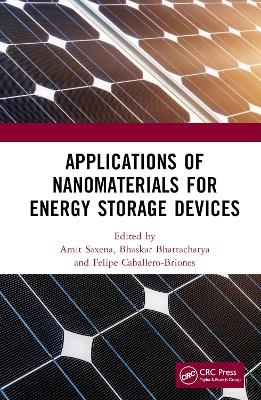
Applications of Nanomaterials for Energy Storage Devices
CRC Press (Verlag)
978-1-032-10631-1 (ISBN)
Electrochemical energy storage devices are the prime interest of researchers and students. This book provides a comprehensive introduction to nanomaterials and their potential applications specifically for electrochemical devices (rechargeable batteries, supercapacitors and so forth) in a coherent and simple manner. It covers fundamental concepts of nanomaterials, chemical and physical methods of synthesis, properties, characterization methods, and related applications.
Features:
Introduces the evolution of nanoparticles in electrochemical energy storage devices.
Provides the detailed information on step-by-step synthesis of nanoparticles.
Discusses different characterization methods (structural, electrical, optical, and thermal).
Includes the use of nanoparticles in various electrochemical devices.
Aims to bridge the gap between the material synthesis and the real application.
This book aims at Senior Undergraduate/Graduate students in Material Chemistry, Electrochemistry and Chemical Engineering, and Energy Storage.
Amit Saxena is a regular faculty from the Department of Physics, Shri Vaishnav Vidyapeeth Vishwavidyalaya, Indore, INDIA. I am also a lifetime member of IAPT, Kanpur (Indian Association of Physics Teachers), and NMS (Nano and Molecular Society), New Delhi. My area of research interest is the application of carbon-based materials, nanoparticles, and biomaterials for electrochemical applications. my research group is extensively working on rechargeable batteries, DSSC, OSC, quantum dots, supercapacitors, etc. Very recently we are actively involved in the extraction of biopolymers from various biomaterials for biodegradable electrochemical devices. Also, filed a patent in this direction. My formation is B.Sc. in Electronics, M.Sc. in Materials Science, and Ph.D. in Mixed Conducting Polymer Electrolytes. I received the gold medal for my PG studies. I have two patents, two books, three chapters, and eight research papers in reputed international journals and publications. My passion is teaching, reading mythological text, and collaborative research communications. I am so thankful to Prof. Felipe Caballero-Briones and Prof. Bhaskar Bhattacharya for accepting my invitation for Co-Editor of this book. Bhaskar Bhattacharya is a Professor of Physics at Mahila Mahavidyalaya, Banaras Hindu University, Varanasi, India. Dr. Bhattacharya has a teaching and research experience of more than 30 years and has more than 100 research papers, 4 book chapters and 2 patents to his credits. His field of research includes Polymer electrolytes, Dye Sensitized Solar Cells, Quantum Dots, Carbon nano structures and Ion Beam interaction. Dr. Bhattacharya had obtained his B.Sc., M.Sc. and Ph.D. degrees in Physics from Banaras Hindu University and has worked at different academic institutions. In addition to teaching and research, Dr. Bhattacharya has been involved in academic administration at different capacities. He has worked as Research Professor at KAIST, Korea and has intensively worked on the nanostructures and quantum dots. Felipe Caballero-Briones is a member of the Mexican Academy of Science and Group Leader of GESMAT, Materials and Technologies for Energy, Health and Environment Group @ Instituto Politecnico Nacional-CICATA Altamira close to Tampico, at the Gulf of Mexico Northeast Coast. The strength of GESMAT is to develop approaches to prepare and modify graphene based, semiconductor and oxide materials by simple chemical/ electrochemical rotes. Within our collaborations, our materials are being applied in solar cells (TFSCs, DSSCs, QDSSCs, BHJSCs), microbial and polymer fuel cells, thermoelectric, supercapacitors, batteries and photocatalytic between other. Also, water remediation, artificial photosynthesis, lubrication, coating for surface protection, materials for dosimetry and for cancer treatment lie in our fields of interest. My formations is B.Sc. in Industrial Chemistry, M.Sc. in advanced technology and Ph.D. in Materials Science and Technology. Travelling, overseas collaboration, as well as science communication are among my passions. I am grateful to Dr Saxena for the invitation as Co-Editor of this book, for his incredible interest in teaching, science and culture
1: Motivation: Nature to Nano
2: Introduction to Nanoscience
3: Fundamentals of Nanomaterials
4: Physical Methods for Synthesis and Thin-Film Deposition
5: Chemical Methods of Synthesis
6: Electronic and Mechanical Properties of Nanoparticles
7: Various Characterization Methods
8: The Fundamental Idea of Electrochemical Devices
9: Application of Nanomaterials for electrochemical devices
10: Rechargeable Batteries with Nanotechnology
| Erscheinungsdatum | 11.11.2022 |
|---|---|
| Zusatzinfo | 22 Tables, black and white; 106 Line drawings, black and white; 26 Halftones, black and white; 132 Illustrations, black and white |
| Verlagsort | London |
| Sprache | englisch |
| Maße | 156 x 234 mm |
| Gewicht | 671 g |
| Themenwelt | Naturwissenschaften ► Biologie |
| Naturwissenschaften ► Chemie ► Physikalische Chemie | |
| Naturwissenschaften ► Physik / Astronomie | |
| Technik ► Maschinenbau | |
| Technik ► Umwelttechnik / Biotechnologie | |
| ISBN-10 | 1-032-10631-X / 103210631X |
| ISBN-13 | 978-1-032-10631-1 / 9781032106311 |
| Zustand | Neuware |
| Informationen gemäß Produktsicherheitsverordnung (GPSR) | |
| Haben Sie eine Frage zum Produkt? |
aus dem Bereich


